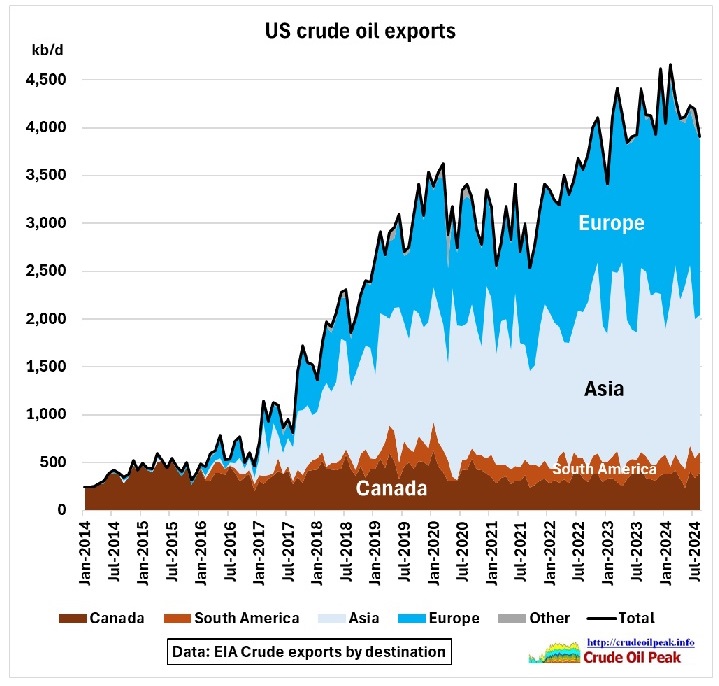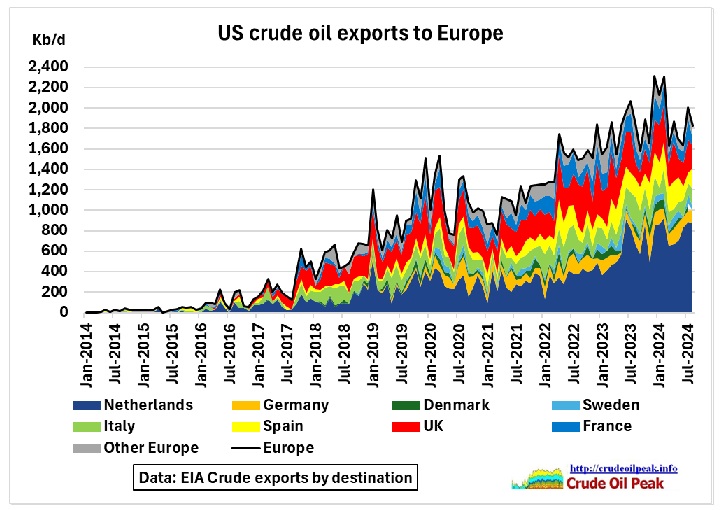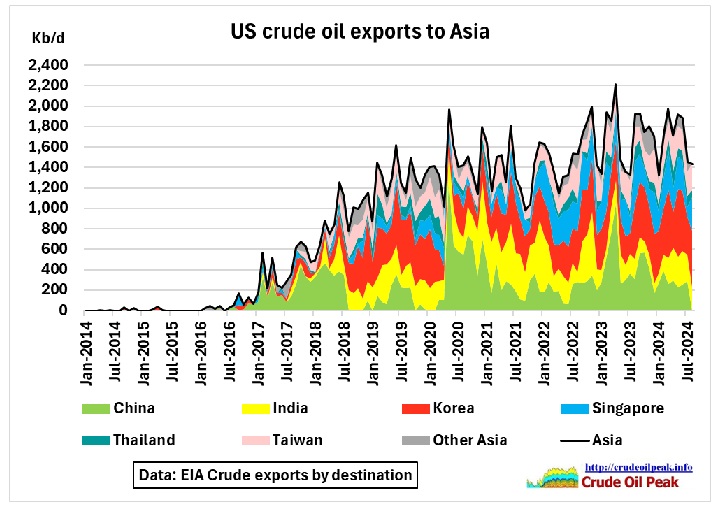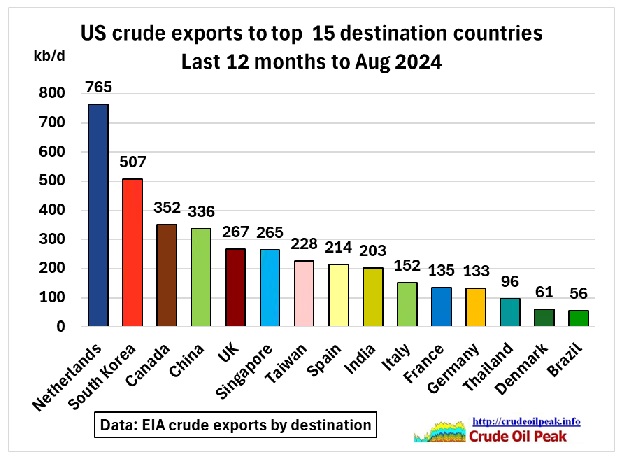The US exported 4.2 mb/d of crude oil in the last 12 months to August 2024. Exports have substantially increased after an export ban ended in December 2015.
Flashback:
This crude oil export ban was in place since Dec 1975 (Energy Policy and Conservation Act) in response to the 1973 oil crisis. Canada was excluded from the ban. Crude from Alaska and California received special licenses as well as re-exports of imports (for example heavy oil from Canada).
US spending bill lifts 40-year ban on crude oil exports
18 Dec 2015
As a trade-off for lifting the ban, the spending bill includes tax breaks for solar and wind power and a pledge by Republicans not to block a $500m payment to the UN Green Climate Fund.
President Obama signed the bill into law on Friday.
https://www.bbc.com/news/business-35136831
9 years later:
 Fig 1: US crude exports by region
Fig 1: US crude exports by region
EIA data start in 2014. US light oil exports to Canada are used to dilute heavy crude in Western Canada and are also needed in refineries in Eastern Canada which are configured for light oil. Thereby, US crude replaced Canadian imports of similar oil from Algeria, UK and Norway (where production had peaked). See chart 7 in:
As can be seen in Fig 1, US exports to Europe and Asia surged by 1.1 mb/d after the Russian invasion in Ukraine following a stagnation due to Covid.

Fig 2: US crude exports to Europe vs to Asia
In the last 12 months, the US exported an average of 1.9 mb/d to Europe and 1.7 mb/d to Asia.
Substituting Russian oil with oil from other countries has its own pitfalls as described in:
Not all oil types are alike in trade substitution
29 Aug 2024
Motivated by the ongoing war in Ukraine and the public debate on sanctioning crude oil imports from Russia, we estimate the elasticity of substitution between different crude oil types. Using European data on country-level crude oil imports by their field of origin, we argue that crude oil is far from a homogenous good, and that the relevant substitutability for analyzing the impact of trade sanctions must account for the quality of different oil types in terms of their density and sulfur content.
Distinguishing crude oil imports by their chemical composition, the elasticity of substitution between types is substantially lower than suggested by previous estimates. Our results also suggest that, by neglecting these differences in quality, standard estimates underestimate the production disruptions and price effects in crude oil refining resulting from sanctions.
https://www.nature.com/articles/s41467-024-51786-9
 Fig 3: US crude exports to Europe by country
Fig 3: US crude exports to Europe by country
Netherlands is by far the largest destination as it serves as a hub to supply refineries in neighbouring countries.
In Northwest Europe, Rotterdam is the absolute leader in the throughput and storage of crude oil. The 95 to 100 million tonnes of crude oil annually entering Rotterdam are almost entirely destined for refineries in the port itself and in the Netherlands, Belgium and Germany. In addition to the import and crude oil storage, the port of Rotterdam also offers opportunities as a distribution hub for petroleum.
https://www.portofrotterdam.com/en/logistics/cargo/liquid-bulk/crude-oil
 Fig 4: US crude exports to Asia
Fig 4: US crude exports to Asia
Main destination countries are South Korea, China, Singapore and India.
 Fig 5: US crude exports to top 15 destinations
Fig 5: US crude exports to top 15 destinations
In October 2020, the US Government Accountability Office (GAO) analysed the impact of US crude exports.
We found that repealing the ban was associated with:
- Expanding the market for U.S. crude oil to overseas buyers
- Allowing producers to charge higher prices relative to comparable foreign oil
- Decreasing profit margins for petroleum refiners as they paid more for domestic crude oil relative to international prices
- Decreasing demand for U.S. tankers to move domestic oil, leading to declines in the U.S. shipping industry
https://www.gao.gov/products/gao-21-118
On the last point:
Sal Mercogliano, a maritime historian at Campbell University and author of the youtube channel “What’s going on with shipping” https://www.youtube.com/c/WhatisGoingonWithShippingwSalMercogliano
has 5 recommendations for the Trump administration as US flagged ships carry only 2% of US imports and exports.
 Fig 6: Screenshot from Sal’s video
Fig 6: Screenshot from Sal’s video
The map shows vessels (regardless of flag) which departed from US ports.
Green = cargo ships, Red = tankers, Blue= tugs and coastal vessels
Five Maritime Reform Proposals for the Trump Administration
Nov 7th 2024
International freight
Coastal freight
Shipbuilding
Seafarers
Cargo preference
https://www.youtube.com/watch?v=3CoOXdpxvIo
This video gives you an idea what the US has to do for geo-strategic reasons. It is worthwhile to watch it. Sal is dedicated and passionate about all shipping topics on his twitter page
https://x.com/mercoglianos
He is also following the impact of Houthi missiles on shipping in the Red Sea and reposts information from other sites complementing his research.
There will be another post on US oil product exports.